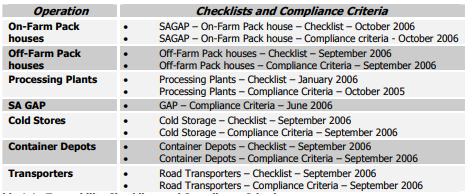As we have already seen, traceability is the ability to trace and follow a food product from the orchard to the basket, or back from the basket to the field or orchard. It is logical that effective recordkeeping is the cornerstone of traceability and the implementation of a traceability system. We also already know that traceability and supporting records for fresh produce are essential components of all quality management systems (QMS).
Checklists and compliance criteria have been developed to be used as an aid and self-assessment tool for food business operators (FBO's) in implementing the food safety system. The same checklists are used by PPECB auditors to verify that the system is in place. In the table below, the checklists and compliance criteria that have to be completed by law in order to ensure effective traceability are set out. Note that checklist and compliance criteria for SA GAP and on-farm packhouses have now been consolidated, therefore making it equally applicable to primary growers and secondary processors and packaging establishments.

Traceability Checklists and Compliance Criteria
Records can be kept manually, by filling the checklists and forms in by hand, or electronically, by recording the information on a computer. Electronic systems have the benefit of also processing the data and additional information can as a result be extracted from these programs.
Computer programs can, for example, deliver graphs and comparisons about the progress of the producer in terms of the quality of his produce. Electronic data can often be used when comparisons are drawn over a period of time. Although manual data can supply the same information, it is a lot more complicated to extract the required information without the assistance of electronic equipment and software.
The records that must be kept in accordance with the requirements of legislation and various food safety accreditation systems serve as evidence of compliance with traceability recommendations because specific information with dates and signatures of responsible parties are found on these documents if they have been filled incorrectly.
All workers that are responsible for traceability records must therefore be trained in:
- How to complete the forms and checklists correctly.
- How, where, when and for how long, to report on and file forms and checklists.
- The accountability and responsibility in terms of traceability and the law related to the completion of (or failure to complete) these forms and checklists.
Records must be kept for a specified period in a central, accessible place, under the care of a person appointed for this task. The records must meet standard criteria of tracking and trace, in order words, they should be kept in a systematic and chronological way, by date, batch number, geographical reference point, and delivery or dispatch reference.